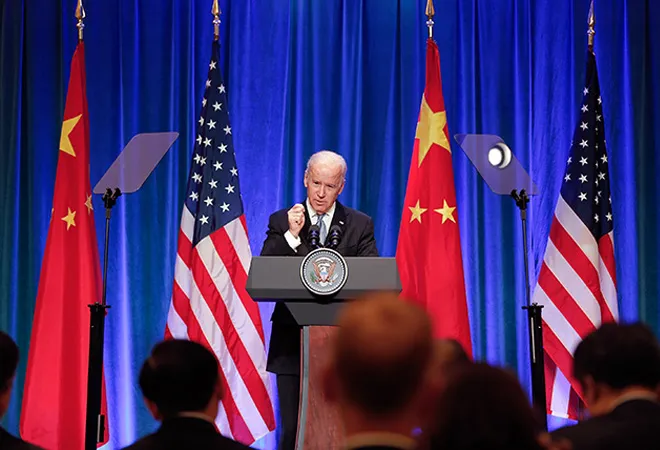One of the biggest questions confronting the future American foreign policy is: What will be the Biden administration’s outlook towards China? If there has been one decisive shift in the Trump era, it has been the change in China’s status from a friend to a peer competitor and, indeed, adversary. This has not come about with any great planning. It began with a seemingly whimsical policy of equalising the trade balance between the two countries, but morphed into a technology war that saw the US pass increasingly restrictive rules against high-tech trade with China. Then, mixed with the Xinjiang and Hong Kong issues, it has brought relations between the two countries to a new Cold War.
Biden and his advisers are savvy enough to realise that China is best handled by taking allies along, something that Trump disdained.
Biden’s political life has ned an era in which there was consensus in US politics and business that the goal of American policy was to integrate China into the US-led world order. He was an early champion of China joining the WTO and argued that it was in America’s self interest to have China prosper. But neither he nor his contemporaries of either party addressed the currency manipulation, the forced transfer and the outright theft of technology that China used to get ahead, issues that hurt America grievously. It was only towards the end of the Obama presidency that the US began to raise the issue of cyber theft, tightening restrictions on Chinese investments in the US, challenging China in the South China Sea.
Trump was a quintessential outsider, not attached to any policy and he had no hesitation in attacking China, the WTO, the WHO or whatever. His signature concern was trade deficits and so he imposed tariffs on most Chinese exports to the US. But this January, he signed a phase I trade agreement with China which would have substantially enhanced China-US trade, but then Covid-19 intervened. Even as he stepped up his attack on China, a clutch of his advisers, Secretary of State Mike Pompeo, trade adviser Peter Navarro, and Deputy National Security Adviser Matt Pottinger, pushed policy aimed at an across-the-board decoupling from China.
There are two aspects of policy now. First, what could Trump do between now and the date he must leave office, January 20, 2021, with regard to China. He is bitter indeed that the pandemic undermined what looked like a shoo-in re-election. Egging him on will be his hardline officials who will want to alter the US policy to China in such fundamental ways that it cannot be undone.
The second is Biden’s own policy thereafter. Though in the Obama administration, Biden was no China hawk, during the presidential campaign to respond to the Trump administration, he has positioned himself as a hardline critic of China who has even called Xi Jinping a ‘thug’ over his treatment of the Uighurs in Xinjiang.
People will be looking to see how he acts on the issue of tariffs and Taiwan, if that issue comes up. But he is unlikely to undo the current consensus that a more forceful and even confrontational approach is needed vis-à-vis Beijing. But one big difference is that instead of the whimsical, go-it-alone Trump style, the Biden administration could make it far more effective by roping in allies and building a consensus. The US now realises that the competition with China is not just over the South China Sea; there is an all-round competition involving technology, ideology and the economy. It’s a big task, and Biden and his advisers are savvy enough to realise that this is best handled by taking allies along, something that Trump disdained.
There are important signals that could be sent at the very outset. If Michele Flournoy is appointed to head the Department of Defence, there will be a hardliner who will not compromise on taking on the Chinese militarily. Likewise, a great deal will depend on the China position of his other Cabinet and sub-Cabinet appointees.
The second, and from India’s point of view, potentially important signal, has been Biden’s promise that he will meet with the Dalai Lama at the earliest. Biden attacked Trump as being the first President in three decades not to have met His Holiness. This will be seen as a hostile act by Beijing.
Biden is unlikely to face opposition in rejoining the Paris climate accord or the WHO, but whether or not he can return the US to the Trans Pacific Partnership (TPP) or begin reducing tariffs on the $360 billion worth of Chinese goods, is not easy to say. His advantage is that many of the things that Trump did was through executive orders (EOs) and did not have the force of legislation, so it should be easy to turn the clock back by simply issuing fresh EOs.
Beyond policies and personalities, there will be larger trends influencing America’s China policy in the post-Covid world. There are shifts in global trade and industrial techniques which will bring supply chains closer home. Biden has said it will encourage this through policy, and possibly even subsidy. The second leg of this policy will be a government-backed campaign to take on China in high-tech areas like AI, quantum computing, 6G and so on. The emphasis will be on making the US more competitive, rather than on blackballing China. Actually, China’s economic strength, the reforms in its financial sector will emerge as a strong magnet for Wall Street and US corporates who will push to moderate any hardline position.
This commentary originally appeared in The Tribune.
The views expressed above belong to the author(s). ORF research and analyses now available on Telegram! Click here to access our curated content — blogs, longforms and interviews.




 PREV
PREV


